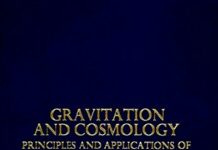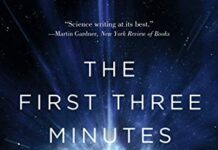
Ebook Info
- Published: 2015
- Number of pages: 443 pages
- Format: PDF
- File Size: 5.24 MB
- Authors: Steven Weinberg
Description
Nobel Laureate Steven Weinberg combines exceptional physical insight with his gift for clear exposition, to provide a concise introduction to modern quantum mechanics, in this fully updated second edition of his successful textbook. Now including six brand new sections covering key topics such as the rigid rotator and quantum key distribution, as well as major additions to existing topics throughout, this revised edition is ideally suited to a one-year graduate course or as a reference for researchers. Beginning with a review of the history of quantum mechanics and an account of classic solutions of the Schrödinger equation, before quantum mechanics is developed in a modern Hilbert space approach, Weinberg uses his remarkable expertise to elucidate topics such as Bloch waves and band structure, the Wigner–Eckart theorem, magic numbers, isospin symmetry, and general scattering theory. Problems are included at the ends of chapters, with solutions available for instructors at www.cambridge.org/9781107111660.
User’s Reviews
Reviews from Amazon users which were colected at the time this book was published on the website:
⭐While there are a multitude of QM textbooks available for students and experts, Steven Weinberg’s bookis still a great addition to the existing QM books.
⭐Having read and reviewed the first edition, I finally just received the second edition (Amazon delayed a couple of times – either there is great demand or they didn’t print enough books). I purchased the second edition for the following reasons:Several new sections (rigid rotator, Van der Walls forces, Rabbi Oscillators, Open systems etc.) expanding the book by about 15%.First edition had many errors and these have now been corrected.Excuse to reread a wonderful book.My name is mentioned in the new preface.I would give give the book 6 stars (out of 5) for content – Weinberg is the best at covering material that other books miss (quantization of constrained systems, and detailed coverage of scattering theory for example), explains difficult material without handwaving arguments, and explicitly shows the calculations. I give the book 4 stars out of five for appearance (notation and look/feel of equations) – the only negative for the book is idiosyncratic notation (refusal to use the Dirac notation), which requires me to mentally convert scalar products to Dirac Brackets. Also, I am not too thrilled with the fonts/typeface that Weinberg uses in his books.This is definitely an advanced book on quantum mechanics. It is graduate level, doesn’t have any pictures or diagrams, and would not be a good choice to learn quantum mechanics for the first time. It is also clearly as titled a lecture book, and not a reference book on QM (for that I would suggest Cohen-Tannoudji). But if you want to review/extend your knowledge of non-relativistic quantum mechanics, whether in a graduate course or by self-study, this is the book I would recommend. Another excellent book which also meets these requirements (and slightly different content coverage) and which also just came out with a second edition is Ballentine’s Quantum Mechanics A Modern Development.
⭐I am starting the second semester undergrad QM class, and this text fills in a lot of the questions I had on problems we encountered in the first class. For a grad class it would be just right to help fill in some of the background needed and math derivations for equations and problem solutions in the class. clearly written, but it assumes a strong background to understand.
⭐Excellent text for new students and experienced physicists. Weinberg’s insight into the essential physics of quantum mechanics is unmatched by other texts with similar titles.
⭐Weinberg’s “Lectures on QM” is an excellent, graduate level text on the quantum mechanics that, among other things, will prepare you for studying quantum field theory. The book is authoritative, and very clearly written. Some highlights: (1) He includes some fascinating topics not easily found in other QM texts. These include a very clear discussion of the Heisenberg ‘matrix mechanics method’ at the beginning of the book, and Pauli’s algebraic solution of the energy levels of the hydrogen atom. (2) The book is very valuable for allowing one to see how Weinberg approaches and formulates solutions for standard introductory quantum mechanical problems (the ‘easy’ problems). (3) Weinberg’s discussion of the interpretations of QM is the clearest and most detailed I have seen anywhere. (4) His chapter on isospin symmetry and its generalization is a very clear introduction to the use of symmetry in QFT. Also, his discussion of symmetry breaking in non-relativistic vs. relativistic cases is quite nice.
⭐The book arrived on time and is new. Weinberg knows exactly what to put in a book on Quantum Mechanics. It covers a lot of topics, traditional as well as modern. It is advanced and seems like a good sequel to Merzbacher’s QM.
⭐This was a classic for all ages before it was ever released – Steven Weinberg on Quantum Mechanics, what more can be said. As a plus, the printing/binding quality is superb. It will be cherished by all physicist.
⭐I met professor Weinberg while I was working on my Ph.D. at UTD. This text is a great study aid while taking quantum mechanics.
⭐The hard bound book is a pleasure to read. Weinberg is an acknowledged master, so there is always something new that one learns from him, even though there are so many other good texts on quantum mechanics. His introductory history chapter is very instructive, like a similar chapter in his QFT books. The treatment in the rest of the book again shows the characteristic thoroughness of his writings.I only wished he had used Dirac notation for convenience of students,though by not using it, he has removed the widely prevalent misconception that Dirac notation is a must for abstract formulation of QM.
⭐Steven Weinberg ist Professor für Physik an der Universität von Texas in Austin, er erhielt 1979 gemeinsam mit Abdus Salam and Sheldon Glashow den Nobelpreis für seine Beiträge zu einer vereinheitlichten Theorie der schwachen und elektromagnetischen Wechselwirkung; von ihm stammt u.a. eine dreibändige Monographie zur Quantenfeldtheorie, darüber hinaus engagiert sich Weinberg für die Popularisierung der modernen Physik und er Wissenschaft im allgemeinen. Von ihm stammen eine ganze Reihe exzellenter populärer Bücher, darunter ‘The First Three Minutes’, ‘The Discovery of Subatomic Particles’ und ‘Dream of a Final Theory’.Die Darstellung basiert auf Vorlesungen die Autor an der Universität von Austin gehalten hat, zwar gibt es dazu zahlreiche ausgezeichnete Texte, einschließlich Diracs ‘Lectures …’, aber keiner entsprach so recht der beabsichtigten Themenauswahl, wie der Autor im Vorwort feststellt. Entsprechend ist der Umfang so dimensioniert, dass das Material für einen einjährigen Kurs für Graduierte ausreicht, die Kapitel sind in Abschnitte gegliedert, die jeweils etwa 75 minütigen Vorlesungen entsprechen.Ohne große Umschweife führt Weinberg physikalische Zustände als Vektoren eines Hilbertraums ein, wobei er auf die bra-ket Notation verzichte, die er für geschickt (awkward) hält. Um dieses Setup didaktisch ein wenig abzumildern, sind ihm je ein Kapitel zur Geschichte der Quantenmechanik, und zur Schrödingerschen Wellengleichung, und deren Anwendung auf das Wasserstoffatom, vorangestellt. Es folgen Spin Systeme, bevor Approximationen, einschließlich der von zeitabhängigen Problemen, Streuung an Potentialen, und die allgemeine Streutheorie in aller Ausführlichkeit behandelt werden. Im folgenden werden Lagrange Formalismus und kanonische Relationen behandelt und auf geladene Teilchen im elektromagnetischen Feld und die Quantentheorie der Strahlung angewandt. Weinberg betont unter anderem die Symmetrie Prinzipien mehr, als das sonst üblich ist, da sie die Rolle der Kommutator Relationen transparenter werden lassen.In vielen Büchern wird die als relativistische Verallgemeinerung der Schrödinger Gleichung behandelt, eine Ansicht, die Weinberg für irrführend hält, statt als Wahrscheinlichkeitsamplitude, sieht er die die Diracsche Wellenfunktion in natürlicher Weise als Matrixelement eines Quantenfeldes, zum Übergang eines ein- Teilchen Zustands ins Vakuum, an. Um einerseits keine zu große Überschneidung mit seinen QFT Werken zu erhalten, andererseits aber auch den gesteckten Umfang des Buch nicht zu sprengen, verzichtet der Autor – ohne Bedauern — ganz auf die Behandlung der relativistischen Quantenmechanik.Das gesamte Buch lebt von der Brillanz des Autors, die Darstellung ist präzise, oft knapp, und Ausdruck von Weinbergs ganz eigenem Stil, das macht die Lektüre nicht immer ganz leicht, da die Entwicklungen gern die gewohnte Pfade verlassen. Die Originalität der Ausführung zeigt sich nicht zuletzt bei dem oft stiefmütterlich behandelten Thema der Interpretation der QM, wo oft nur lieblos die Kopenhagener Deutung repetiert wird, untersucht der Autor verschieden Auffassungen. Gerade bei der Abfassung der zweiten Edition, wurde Weinberg bewusst, dass keine der Varianten so recht zufriedenstellen kann, und so wurde dieser Abschnitt in der neuen Ausgabe mit am umfangreichsten erweitert — kaum jemand hat die Probleme so präzise in einer Frage zusammengefasst: ‘Woher kommen die Wahrscheinlichkeiten in der Quantenmechanik?’ – denn aus der Schrödingergleichung können ja die Bornschen Regeln nicht ableitet werden. Die Beschäftigung mit dieser Frage hat Weinberg sogar veranlasst, seine Überlegungen allgemein verständlich in dem Essay ‘The Trouble with Quantum Mechanics’ (in: Third Thoughts) dazulegen.El libro fue escrito por uno de los físicos más importantes de la actualidad, de modo que resulta interesante conocer los temas que considera prioritarios. El texto es muy ameno, pero sólo si uno ya conoce el tema (el autor considera que su texto es para alumnos de posgrado). Antes de comprar el libro toma en cuenta que Weinberg no se molestó en poner figuras ni en ocupar la notación de Dirac.I am going to focus on the quality of the book because contents are easier to be familiar with and of course with the author’s authority on the field.The quality of this book is superb! It is not a cheep crap print on demand book; rather it is a high standard printing quality (like the old Springer books).And for the price, compared to those of Springer or Cambridge University Press or Oxford University Press, this is great deal!
⭐All’inizio il libro può risultare ostico e inutile, ma con la giusta dedizione e le giuste integrazioni (magari anche il giusto docente che spiega) diventa il punto di riferimento dove andare a cercare tutto ciò di cui si ha bisogno.Poi è punto di vista di un uomo che con la meccanica quantistica ci ha fatto grandi cose, quindi già questo dovrebbe essere un punto a favore rispetto ad altri testi più “scolastici”
Keywords
Free Download Lectures on Quantum Mechanics 2nd Edition in PDF format
Lectures on Quantum Mechanics 2nd Edition PDF Free Download
Download Lectures on Quantum Mechanics 2nd Edition 2015 PDF Free
Lectures on Quantum Mechanics 2nd Edition 2015 PDF Free Download
Download Lectures on Quantum Mechanics 2nd Edition PDF
Free Download Ebook Lectures on Quantum Mechanics 2nd Edition




